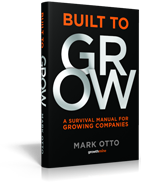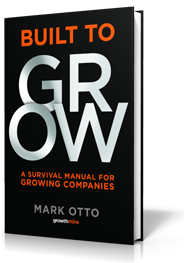
Do the People in Your Company Know Who is Responsible for What?

Understanding roles and responsibilities is pretty clear in a small organization. But as a company gets bigger, things that were understood as a matter of course must be made explicit. Everyone in an organization needs to know who is responsible for what and who has the authority for what.
Unclear responsibility is one of the most common pitfalls in a growing business. Show me a rapidly growing organization and I’ll show you managers with misaligned goals and vague responsibility.
A key challenge in a growing business is the coordination of:
“Who’s going to do what?”
“What part of the job is mine and what is yours?”
“Whose responsibility is it?”
Confusion Causes Problems
In the melee caused by growth, new duties and areas of responsibilities pile up rapidly. Often they are assigned or assumed haphazardly. Functions become muddled by ad hoc decisions required to handle the latest crisis. Other new functions evolve and do not get covered at all.
As your company grows, people are often confused about their evolving roles and responsibilities. The organizational chart is difficult to understand, and the rationale for reporting lines is often unclear. Rapidly growing organizations tend to be full of uncertainty and ambiguity caused by a steady stream of incoming employees, and constantly changing job demands, structures, and processes.
New employees do not know each other, do not know the company, and don’t know who does what. When people don’t understand expectations or what they are supposed to be doing, they are left to figure it out on their own. Letting confusion exist can negatively impact productivity, profitability, and creativity.
Friction Leads to Breakdowns
When who is responsible for what is unclear or constantly changing, people do what they want. As everything becomes someone else’s responsibility, friction erupts between individuals and departments. The organization can become a group of divided silos. Decisions may be made that are in the best interest of an individual or a department, but not necessarily good for the organization.
Unclear roles may make it impossible to tell exactly who is responsible when things go wrong. When the left hand does not know what the right is doing, some work never gets completed and people say, “I thought they were the ones responsible for that.” Too many things “fall through the cracks” and no one takes responsibility. When things go wrong, finger pointing begins; people claim they lacked authority, had no input into the decisions made by others, or they didn’t have sufficient information, ultimately placing blame on other departments or individuals.
Ill-defined Responsibilities Result in Wasted Efforts
Ill-defined roles and responsibilities can also lead to duplication of effort between departments. Since no one knows precisely who is responsible for a particular task, two or more departments or people may work on the same thing only to find that someone else has already completed it.
How individuals and departments should be working together may also be unclear. Individuals and departments don’t have a sense of their domain; they don’t know where their job stops and another job starts. When a company is small, people develop an understanding of how their responsibilities dovetail with each other. As a company gets bigger, however, ad hoc structures with multiple dotted lines lead to numerous “blind spots.”
Success Depends on Clarity and Communication
Rapid growth requires a steady stream of information across departmental lines and close cross-functional coordination. People often complain about poor communication and that may be part of the problem but, more likely, roles, responsibilities, and levels of authority are simply poorly defined.
Specifically, you must clarify expectations. “Knowing what is expected” is more than a job description. It’s a detailed understanding of how one person’s role and responsibilities fit in with what everyone else is supposed to do, and how those expectations change when circumstances change. It’s about clearly understanding how what each person does affects results.
Clarifying expectations upfront is a primary driver of on-the-job performance and employee engagement.
Align Goals With Responsibilities
When everybody is responsible, nobody is responsible. Two people shouldn’t have the same functional responsibility or own the same goal. If you do that, you’re asking for things to fall through the cracks.
For every key result you want from your organization, you need to have a functional leader and unit wholly responsible for that one result. In a smaller organization, or for a smaller task, the responsible “unit” might be a particular person. But always, a one-to-one relationship must exist between the organizational structure and the organizational goals and objectives.
Areas where there are overlapping responsibilities must be eliminated. It has to be crystal clear what function, department, team, or individual owns a result. You must design an organizational structure that allows you to pinpoint who is responsible for what.
Is it always clear who is responsible for what in your business?





